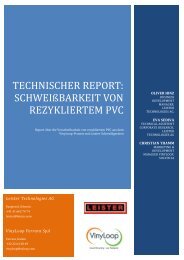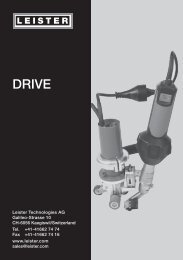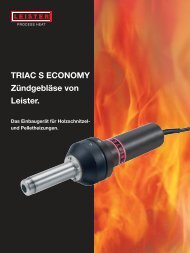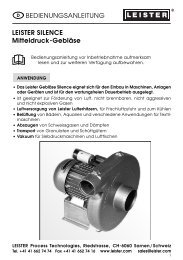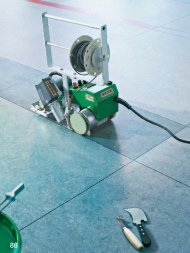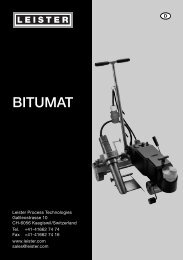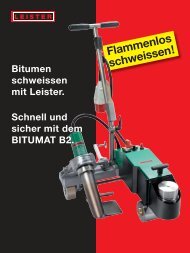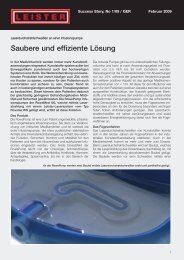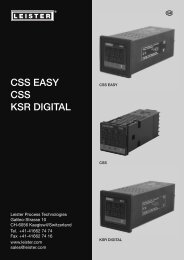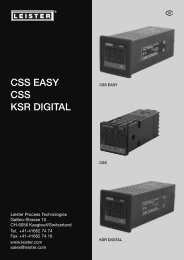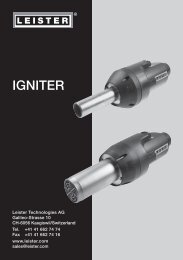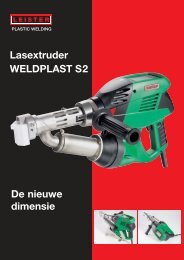Welding PUR-coated floors with Leister
Welding PUR-coated floors with Leister
Welding PUR-coated floors with Leister
Create successful ePaper yourself
Turn your PDF publications into a flip-book with our unique Google optimized e-Paper software.
PLASTIC WELDING<br />
<strong>Welding</strong> <strong>PUR</strong>-<strong>coated</strong> <strong>floors</strong> <strong>with</strong> <strong>Leister</strong><br />
Products can change quickly no matter what the sector.<br />
The trend towards a wide variety of different products <strong>with</strong><br />
an almost limitless array of potential arguments does not<br />
stop at the flooring sector. New products such as <strong>PUR</strong><br />
(polyurethane) <strong>coated</strong> <strong>floors</strong> promise customers greater<br />
benefits. For the floor layer though, they entail greater care<br />
and, above all, the right choice of tool!<br />
Plastic <strong>floors</strong> – tried-and-tested technology<br />
Plastic <strong>floors</strong> have successfully been welded using hot air (hotgas<br />
extrusion welding) for several decades now. This technology<br />
has become established around the world, from residential and<br />
business premises, railways, trams and elevators through to<br />
hospitals. Numerous alternatives have been tested, though<br />
usually <strong>with</strong>out success.<br />
Frequent error scenarios for <strong>PUR</strong>-<strong>coated</strong> <strong>floors</strong><br />
Floor layers who did not have any problems <strong>with</strong> conventional<br />
floor coverings have been confronted <strong>with</strong> new materials <strong>with</strong>out<br />
prior warning, materials that cannot be worked <strong>with</strong> so easily as<br />
the established «classics». As the result, the following errors<br />
haven been encountered when incorrectly welding <strong>PUR</strong>-<strong>coated</strong><br />
plastic <strong>floors</strong>:<br />
a) <strong>PUR</strong>-surface is destroyed or totally melted off.<br />
Possible cause: Preheating air applied to widely.<br />
b) <strong>PUR</strong>-surface looks like orange skin in the seam areas.<br />
Possible cause: Preheating air applied to widely.<br />
c) Floor has risen on both sides of the seam area.<br />
The side areas beside the groove have been softened toomuch.<br />
These side areas then rise too high as a result of the subsequent<br />
pressure in the groove (caused by applying the welding seam).<br />
These rises are then scraped off excessively when smoothing<br />
down <strong>with</strong> the quarter-moon knife.<br />
d) Inadequate quality of the weld.<br />
The weld exhibits an unsatisfactory visual quality in the transition<br />
area between the <strong>PUR</strong> surface and filled groove. Small notches<br />
can occur.<br />
e) Poorly prepared groove.<br />
The groove edges are not milled neatly, which means they are<br />
slightly frayed.<br />
The effects of b and c alter the contamination behaviour in the<br />
seam area which, although not always noticed straightaway,<br />
often results in complaints later. Scenario d can have a negative<br />
effect on the long-term behaviour. A notch acts like a predetermined<br />
fracture point.<br />
The basics of plastic welding<br />
Whether in plastic container construction or for plastic flooring:<br />
The physics behind welding remains the same. This means the<br />
following principles always have to be observed:<br />
Application Note, No 2/08 / ENG February 2008<br />
Only thermoplastic plastics can be welded<br />
Only the same materials can be welded to one another<br />
The parameters of heat, pressure, time and speed are the<br />
main influencing factors<br />
Different plastics have different application and processing<br />
temperatures<br />
Challenge of welding floor covers <strong>with</strong> <strong>PUR</strong> surface<br />
<strong>PUR</strong> has different thermal properties than PVC. In concrete terms,<br />
this means lower plasticizing and decomposition temperatures. The<br />
<strong>PUR</strong> surface is already destroyed at processing temperatures which<br />
would be regarded as normal for PVC.<br />
Tried-and-tested processing technology <strong>with</strong> hot air.<br />
The elemental significance of heat<br />
Several more or less creative solutions have meanwhile been<br />
published or fished out from lists of handy tricks. As previously<br />
mentioned, the parameters of heat, pressure, time and speed<br />
have to be overcome. The welding areas (filler rod and complete<br />
groove) need to be brought to the welding temperature, <strong>with</strong>out
damaging the <strong>PUR</strong> surface. Applying the heat at the right location<br />
poses the major challenge for these new floor covers. In other<br />
words, it is necessary to work in a very narrow process window<br />
between «well welded» and «surface not yet damaged».p<br />
The <strong>Leister</strong> solution<br />
In order not to destroy the surface, a very narrow, hot jet of air<br />
has to be directed right to the centre of the groove and the air<br />
flowing backwards must heat up the side flanks. Plastic needs<br />
time in order to absorb the heat. In order to attain reliable<br />
welding speeds, the heat should have an effect not only on one<br />
point but over a longer section. The magic word is air-knife<br />
technology: a knife-sharp jet of air, which is directed into the<br />
centre of the groove <strong>with</strong> great precision. This jet of air makes it<br />
possible to heat the inner areas of the groove up to the welding<br />
temperature <strong>with</strong>out destroying the <strong>PUR</strong> surface. Of course, this<br />
not only works for manual extrusion welding, but also for welding<br />
machines. As the preheating air can act over several millimetres<br />
<strong>with</strong> the rapid welding nozzle or several centimetres <strong>with</strong> the<br />
welding machine, viable welding speeds are possible.<br />
The new air-knife-nozzle for the UNIFLOOR E provides a jet of<br />
air as sharp as a knife.<br />
Manual welding<br />
A manual device <strong>with</strong> controlled temperature setting, as <strong>with</strong> the<br />
<strong>Leister</strong> TRIAC PID, is a must for accurate work. The rapid welding<br />
nozzle <strong>with</strong> small air slit also enables floor covers <strong>with</strong> a <strong>PUR</strong> surface<br />
to be processed <strong>with</strong>out any problem.<br />
Clean welding quality<br />
High welding speed<br />
With linoleum, the 5mm nozzle can be used for the 4 mm cord<br />
No melting adhesion problems when welding linoleum, as is the<br />
case for solutions <strong>with</strong> an integrated pressure roller.<br />
Rapid welding nozzle on <strong>Leister</strong> TRIAC PID for accurate work.<br />
<strong>Welding</strong> <strong>with</strong> <strong>Leister</strong> welding machine<br />
A professional welding machine like the <strong>Leister</strong> UNIFLOOR E is<br />
naturally used for welding larger sections. A special nozzle <strong>with</strong><br />
air-knife technology has been developed for floor covers <strong>with</strong> a<br />
<strong>PUR</strong> surface.<br />
Infinite adjustment options for all parameters such as air<br />
temperature, air volume and speed<br />
Reproducible settings for all parameters thanks to display<br />
Monitoring of all parameters<br />
Economically more efficient laying thanks to high welding speed<br />
Optimum welding quality also for <strong>PUR</strong> surfaces<br />
Proven solution <strong>with</strong> established <strong>Leister</strong> quality<br />
Hot air welding machine <strong>Leister</strong> UNIFLOOR E<br />
Milling grooves<br />
Precisely milled welding grooves and neat edges are a must for<br />
high-quality and visually flawless weld joints. Special attention must<br />
be paid to this for <strong>PUR</strong> surfaces in particular. Even hard floor<br />
covers can be processed optimally <strong>with</strong> the <strong>Leister</strong> GROOVER. A<br />
wide range of milling tools are available to meet all requirements.<br />
Joint milling tool <strong>Leister</strong> GROOVER<br />
<strong>Leister</strong> accessories:<br />
<strong>Welding</strong> nozzle <strong>with</strong> air-knife technology for <strong>PUR</strong>-<strong>coated</strong> floor<br />
covering suitable for <strong>Leister</strong> UNIFLOOR E: Art. no. 103.394<br />
Rapid welding nozzles <strong>with</strong> narrow air slit:<br />
Art. no. 105.431 3 mm<br />
Art. no. 105.432 4 mm<br />
Art. no. 105.433 5 mm<br />
Headquarters: <strong>Leister</strong> Process Technologies<br />
Riedstrasse<br />
6060 Sarnen/Switzerland<br />
phone +41 41 662 74 74 fax +41 41 662 74 16<br />
© Copyright by <strong>Leister</strong><br />
www.leister.com<br />
<strong>PUR</strong>-Böden/ENG/03.2008



